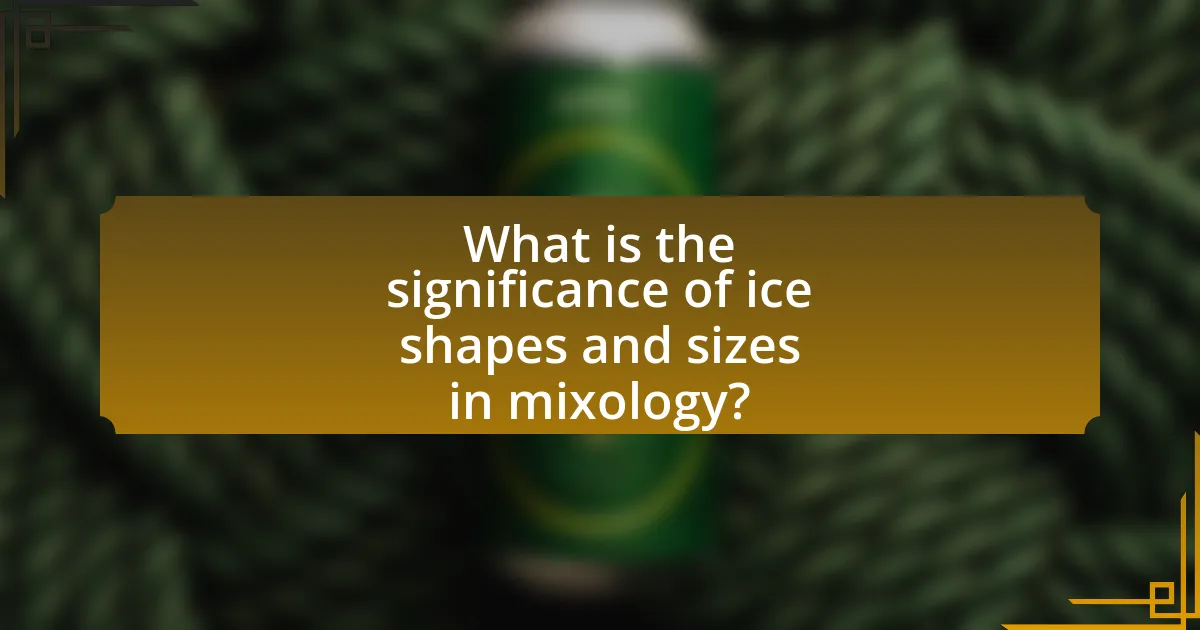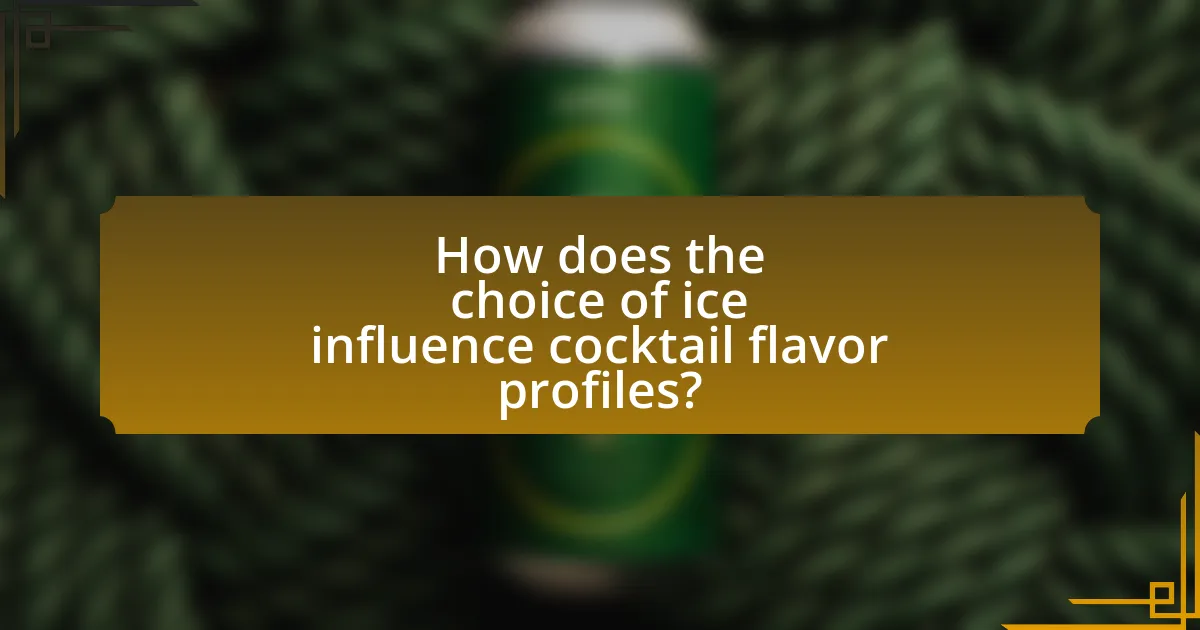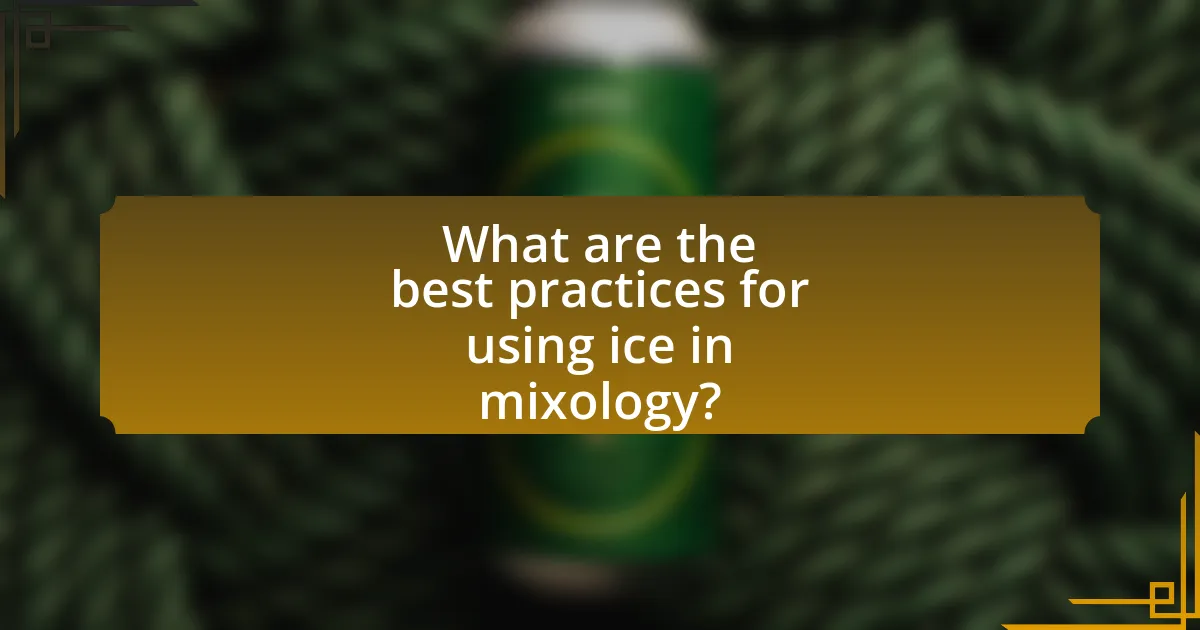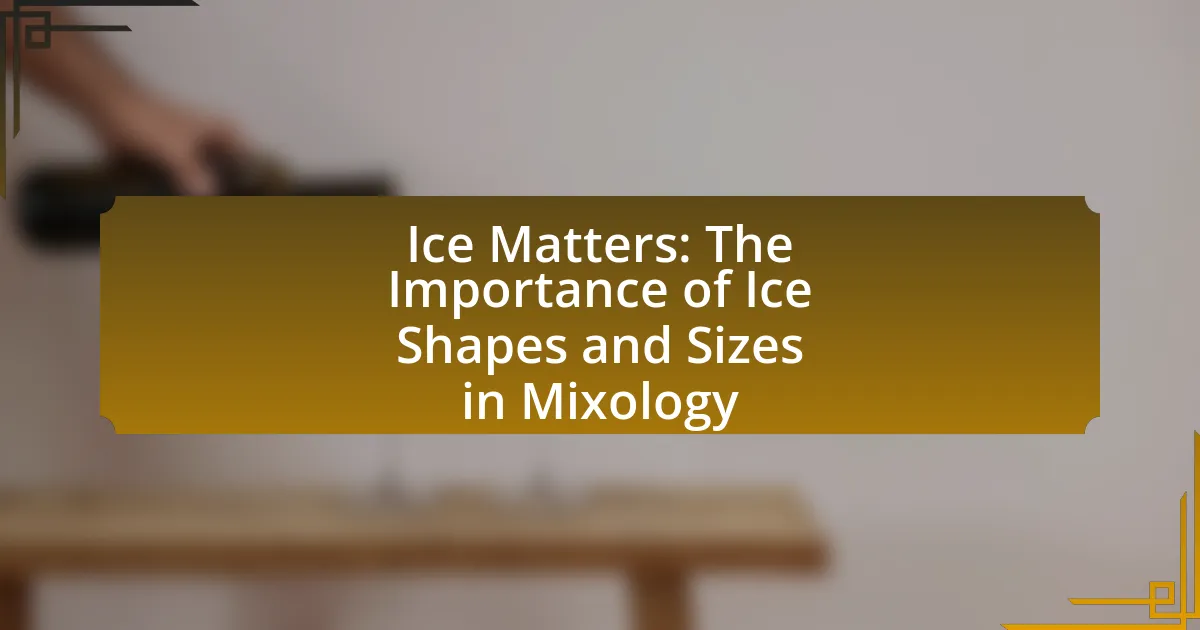The article “Ice Matters: The Importance of Ice Shapes and Sizes in Mixology” examines the critical role that ice plays in cocktail preparation, focusing on how different shapes and sizes affect dilution rates, temperature, and presentation. It highlights that larger ice cubes melt more slowly, preserving the drink’s flavor, while smaller ice shapes can lead to over-dilution. The article also discusses various types of ice used in mixology, the impact of surface area on melting rates, and best practices for ice selection to enhance the overall drinking experience. Additionally, it addresses the importance of ice purity and innovative techniques for improving cocktail quality.

What is the significance of ice shapes and sizes in mixology?
Ice shapes and sizes are significant in mixology because they directly influence the dilution rate, temperature, and presentation of cocktails. Larger ice cubes melt more slowly, providing a gradual dilution that preserves the drink’s flavor, while smaller ice shapes chill beverages quickly but can lead to over-dilution. For example, a study published in the Journal of Food Science found that larger ice cubes can maintain a cocktail’s integrity longer than crushed ice, which can alter the drink’s taste and texture. Additionally, the visual appeal of different ice shapes enhances the overall drinking experience, making cocktails more aesthetically pleasing and engaging for consumers.
How do different ice shapes affect the dilution of cocktails?
Different ice shapes affect the dilution of cocktails primarily through their surface area and melting rate. Larger ice shapes, such as ice cubes, have a smaller surface area relative to their volume, resulting in slower melting and less dilution over time. In contrast, smaller ice shapes, like crushed ice or ice shards, have a greater surface area, leading to faster melting and increased dilution. Research indicates that cocktails served with larger ice shapes maintain their intended flavor profile longer due to reduced dilution rates, while cocktails with smaller ice shapes can become watered down more quickly, altering the taste and balance of the drink.
What are the various types of ice shapes used in mixology?
The various types of ice shapes used in mixology include cubes, spheres, crushed ice, and large blocks. Ice cubes are the most common shape, providing a balance of slow melting and cooling. Spheres, often used in upscale cocktails, melt slower than cubes, minimizing dilution. Crushed ice is ideal for cocktails that require rapid chilling and is often used in tiki drinks. Large blocks of ice are favored for their slow melting properties, making them suitable for spirit-forward cocktails. Each shape serves a specific purpose in enhancing the drink’s temperature, dilution rate, and overall presentation.
How does the surface area of ice influence melting rates?
The surface area of ice significantly influences melting rates, with larger surface areas leading to faster melting. This occurs because increased surface area allows for greater exposure to warmer air and liquid, facilitating heat transfer. For instance, crushed ice, which has a higher surface area compared to larger ice cubes, melts approximately 50% faster due to this enhanced interaction with the surrounding environment. This principle is crucial in mixology, where the choice of ice shape and size can affect the dilution rate of beverages, impacting flavor and temperature.
Why is the size of ice cubes important in drink preparation?
The size of ice cubes is important in drink preparation because it directly affects the dilution rate and temperature of the beverage. Larger ice cubes melt more slowly, resulting in less dilution and maintaining the drink’s intended flavor profile for a longer period. In contrast, smaller ice cubes melt quickly, leading to faster dilution and potentially altering the drink’s taste. Studies have shown that the surface area of ice impacts how quickly it absorbs heat, with larger cubes having less surface area relative to their volume, thus minimizing the rate of melting. This principle is crucial in mixology, where the balance of flavors is essential for a well-crafted drink.
What are the effects of large ice cubes versus small ice cubes?
Large ice cubes melt more slowly than small ice cubes, resulting in less dilution of beverages over time. This slower melting rate is due to the smaller surface area-to-volume ratio of large ice cubes, which minimizes the rate at which they absorb heat from the surrounding liquid. Consequently, drinks served with large ice cubes maintain their intended flavor profile and temperature longer, making them preferable for cocktails that benefit from a more controlled dilution. In contrast, small ice cubes, with their larger surface area, melt quickly, leading to faster dilution and potentially altering the taste and strength of the drink. This difference in melting rates is crucial in mixology, as it affects the overall drinking experience.
How does ice size impact the temperature of a cocktail?
Ice size significantly impacts the temperature of a cocktail by influencing the rate of dilution and the surface area exposed to the liquid. Larger ice cubes melt more slowly than smaller ones, resulting in less dilution over time, which helps maintain the cocktail’s intended flavor and temperature. Conversely, smaller ice pieces have a greater surface area relative to their volume, leading to quicker melting and faster temperature reduction of the cocktail. Studies show that cocktails served with larger ice can remain colder for longer periods without becoming overly diluted, preserving the drink’s integrity and taste.
What role does ice play in the overall presentation of a cocktail?
Ice serves a crucial role in the overall presentation of a cocktail by enhancing visual appeal and influencing the drink’s temperature and dilution rate. The clarity, size, and shape of ice can significantly affect how a cocktail looks and feels; for instance, large, clear ice cubes create a sophisticated aesthetic, while crushed ice can evoke a more casual vibe. Additionally, the use of ice impacts the cocktail’s dilution, which is essential for balancing flavors and maintaining the intended taste profile. Research indicates that the size and shape of ice can alter the rate of melting, thereby affecting the drink’s overall experience.
How can ice shapes enhance the visual appeal of drinks?
Ice shapes enhance the visual appeal of drinks by adding aesthetic variety and sophistication. Unique ice shapes, such as spheres or large cubes, create a striking contrast against the liquid, making the drink more visually engaging. For instance, spherical ice melts slower than traditional cubes, maintaining the drink’s clarity and presentation longer, which is particularly important in high-end mixology. Additionally, the use of clear ice, achieved through specific freezing techniques, can showcase the drink’s colors and garnishes, further elevating its visual impact. Studies in mixology emphasize that presentation significantly influences consumer perception and enjoyment, reinforcing the importance of ice shapes in creating an appealing drink experience.
What are some creative uses of ice in cocktail garnishing?
Creative uses of ice in cocktail garnishing include crafting ice spheres, incorporating edible flowers or herbs into ice cubes, and using flavored ice to enhance the drink’s profile. Ice spheres, which melt slower than traditional cubes, maintain the drink’s temperature without diluting it quickly, making them ideal for cocktails like whiskey or scotch. Edible flowers or herbs frozen within ice cubes not only add visual appeal but also infuse the drink with subtle flavors as they melt. Flavored ice, made from fruit juices or herbal infusions, can elevate cocktails by adding complementary tastes, such as citrus ice in a gin and tonic. These techniques enhance both the aesthetic and sensory experience of cocktails, demonstrating the versatility of ice in mixology.

How does the choice of ice influence cocktail flavor profiles?
The choice of ice significantly influences cocktail flavor profiles by affecting dilution rates and temperature. Different ice shapes and sizes, such as large cubes or crushed ice, alter how quickly the ice melts, which in turn impacts the balance of flavors in the drink. For instance, larger ice cubes melt more slowly, providing a gradual dilution that preserves the cocktail’s intended flavor, while crushed ice melts quickly, leading to a more pronounced dilution and potentially altering the taste. Studies have shown that the melting rate of ice can change the concentration of flavors in a cocktail, thereby affecting the overall drinking experience.
What are the flavor implications of using different types of ice?
Different types of ice can significantly affect the flavor profile of beverages. For instance, larger ice cubes melt more slowly, resulting in less dilution and allowing the original flavors of the drink to remain intact longer. Conversely, crushed ice melts quickly, leading to faster dilution and a more watered-down taste, which can alter the intended flavor balance of cocktails. Additionally, the purity of the ice, influenced by the water source and freezing method, can introduce subtle flavors or impurities that impact the overall taste experience. Studies have shown that the clarity and composition of ice can affect the sensory perception of drinks, emphasizing the importance of selecting the appropriate ice type for optimal flavor delivery.
How does the purity of ice affect the taste of cocktails?
The purity of ice significantly affects the taste of cocktails by influencing the clarity and flavor profile of the drink. Pure ice, made from distilled water, contains fewer impurities and minerals, which prevents unwanted flavors from leaching into the cocktail. In contrast, ice made from tap water may introduce chlorine or other contaminants, altering the intended taste of the drink. Studies have shown that the quality of ice can impact the overall sensory experience, as impurities can lead to off-flavors that detract from the cocktail’s intended profile. Therefore, using pure ice enhances the cocktail’s flavor and maintains its intended taste.
What are the best practices for making clear ice for cocktails?
To make clear ice for cocktails, the best practices include using distilled water, freezing in a cooler or insulated container, and allowing the ice to freeze slowly. Distilled water minimizes impurities that cause cloudiness, while an insulated container promotes directional freezing, which pushes air bubbles and impurities to the bottom. This method results in clearer ice, as confirmed by ice-making experts who emphasize the importance of these techniques for achieving high-quality ice suitable for cocktails.
Why is it important to consider ice when crafting signature cocktails?
Considering ice is crucial when crafting signature cocktails because it affects dilution, temperature, and presentation. The type and size of ice influence how quickly a cocktail chills and how much it dilutes over time. For instance, larger ice cubes melt slower than smaller ones, allowing for a more controlled dilution, which is essential for maintaining the intended flavor profile of the drink. Additionally, the visual appeal of ice can enhance the overall presentation, making the cocktail more enticing. Studies in mixology highlight that the right ice can elevate the drinking experience by balancing temperature and flavor, thereby reinforcing the importance of ice in cocktail preparation.
How can bartenders tailor ice choices to specific cocktail recipes?
Bartenders can tailor ice choices to specific cocktail recipes by selecting the appropriate ice shape and size that influences dilution and temperature. For example, larger ice cubes melt slower, making them ideal for spirit-forward cocktails like an Old Fashioned, as they maintain the drink’s integrity while chilling it. Conversely, crushed ice is suitable for cocktails like a Mojito, where rapid dilution and a frosty texture enhance the drinking experience. Research indicates that the surface area of ice affects the rate of melting, which directly impacts the cocktail’s flavor profile and overall enjoyment.
What are some examples of cocktails that rely heavily on ice characteristics?
Cocktails that rely heavily on ice characteristics include the Mint Julep, the Old Fashioned, and the Daiquiri. The Mint Julep requires crushed ice to create a frosty texture that enhances its refreshing qualities, while the Old Fashioned benefits from large ice cubes that melt slowly, preventing dilution and maintaining the drink’s integrity. The Daiquiri, when served over finely crushed ice, achieves a slushy consistency that is essential for its flavor profile. These cocktails demonstrate how different ice forms impact the overall drinking experience, emphasizing the importance of ice in mixology.

What are the best practices for using ice in mixology?
The best practices for using ice in mixology include selecting the appropriate ice shape and size, ensuring cleanliness, and managing dilution effectively. Using larger ice cubes or spheres minimizes surface area, leading to slower melting and reduced dilution, which is crucial for maintaining the integrity of the drink’s flavor. Clear ice is preferred as it is free from impurities and air bubbles, enhancing the visual appeal and taste. Additionally, pre-chilling glassware and ingredients can help maintain the desired temperature without excessive ice use, further controlling dilution. These practices are supported by industry standards that emphasize the role of ice in achieving optimal drink quality and presentation.
How can bartenders effectively manage ice inventory?
Bartenders can effectively manage ice inventory by implementing a systematic approach to tracking usage and replenishment. This involves regularly monitoring the amount of ice used during service hours, forecasting peak times based on historical sales data, and adjusting orders accordingly to maintain optimal stock levels. For instance, a bar that serves an average of 50 cocktails per hour during peak times may require a specific quantity of ice, which can be calculated based on the average ice per drink. Additionally, maintaining proper storage conditions, such as keeping ice in insulated bins to prevent melting, ensures that the inventory remains usable for longer periods. This method not only minimizes waste but also ensures that bartenders have sufficient ice on hand to meet customer demand, thereby enhancing service efficiency.
What are the storage tips for maintaining ice quality?
To maintain ice quality, store ice in a dedicated, insulated container to prevent melting and contamination. Insulated containers minimize temperature fluctuations, which helps preserve the ice’s integrity. Additionally, avoid storing ice near strong odors or foods, as ice can absorb these smells, affecting its taste. Regularly clean the storage container to prevent any buildup of impurities that could compromise ice quality.
How can ice be prepared in advance for busy service periods?
Ice can be prepared in advance for busy service periods by utilizing large-capacity ice makers or ice storage bins to produce and store significant quantities of ice ahead of time. This method ensures that sufficient ice is available during peak service hours, minimizing wait times and maintaining service efficiency. Additionally, pre-packaging ice in bags or containers allows for quick access and distribution, further streamlining the service process. Studies indicate that establishments with efficient ice preparation systems can reduce service delays by up to 30%, highlighting the importance of proactive ice management in busy environments.
What common mistakes should be avoided when using ice in cocktails?
Common mistakes to avoid when using ice in cocktails include using the wrong ice size, which can affect dilution and temperature; failing to chill glassware, leading to a warmer drink; and reusing melted ice, which dilutes the cocktail and alters its flavor. Using large ice cubes is recommended as they melt slower, maintaining the drink’s integrity, while pre-chilling glassware ensures optimal serving temperature. Additionally, fresh ice should always be used to prevent unwanted flavors from previously melted ice.
How can improper ice usage affect drink quality?
Improper ice usage can significantly degrade drink quality by altering temperature, dilution rates, and presentation. When ice is too small, it melts quickly, leading to excessive dilution that can weaken flavors and disrupt the intended balance of ingredients. Conversely, oversized ice may not chill the drink effectively, resulting in a less refreshing experience. Additionally, using dirty or improperly stored ice can introduce unwanted flavors and contaminants, further compromising the drink’s integrity. Studies indicate that the shape and size of ice can influence the rate of melting and the overall sensory experience, underscoring the importance of proper ice selection in mixology.
What troubleshooting tips can help bartenders improve their ice techniques?
To improve their ice techniques, bartenders should focus on the quality, size, and shape of the ice used in cocktails. Using clear, well-formed ice reduces dilution and enhances presentation, as clear ice melts slower than cloudy ice, maintaining the drink’s integrity longer. Additionally, bartenders should ensure they are using the appropriate ice size for each drink; larger ice cubes are ideal for slow dilution in stirred drinks, while smaller cubes or crushed ice work better for cocktails that require rapid chilling. Regularly cleaning ice bins and using sanitized tools can prevent contamination and maintain ice quality. These practices are supported by industry standards that emphasize the role of ice in drink quality and customer satisfaction.
What are some innovative ice techniques to enhance cocktail experiences?
Innovative ice techniques to enhance cocktail experiences include using large ice cubes, ice spheres, and flavored ice. Large ice cubes melt slower, minimizing dilution and maintaining the cocktail’s integrity, while ice spheres provide a visually appealing option that also melts slowly. Flavored ice, made from juices or herbs, adds an extra layer of taste as it melts, enhancing the overall flavor profile of the drink. These techniques are supported by mixology practices that emphasize the importance of ice in maintaining the balance of flavors and presentation in cocktails.
